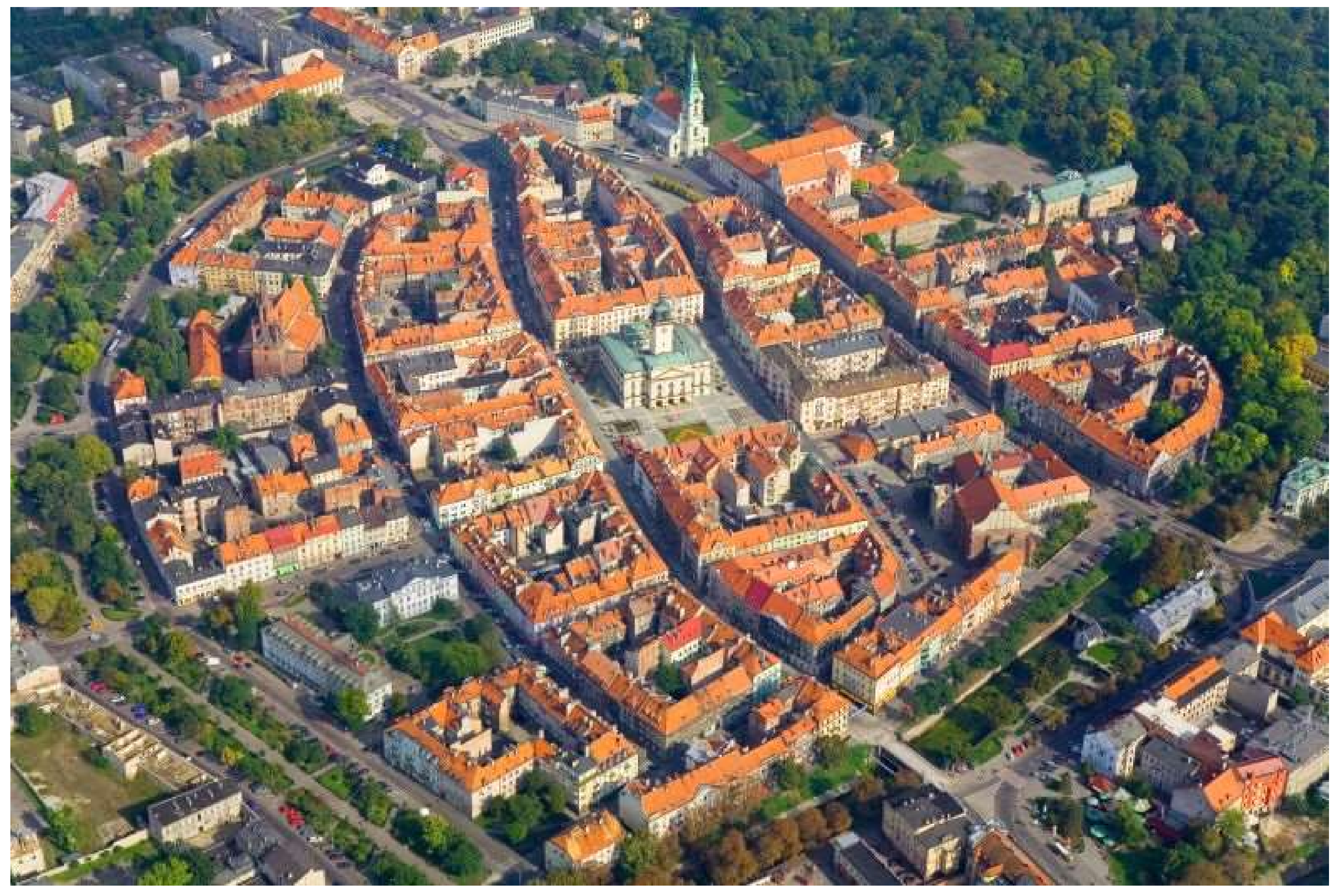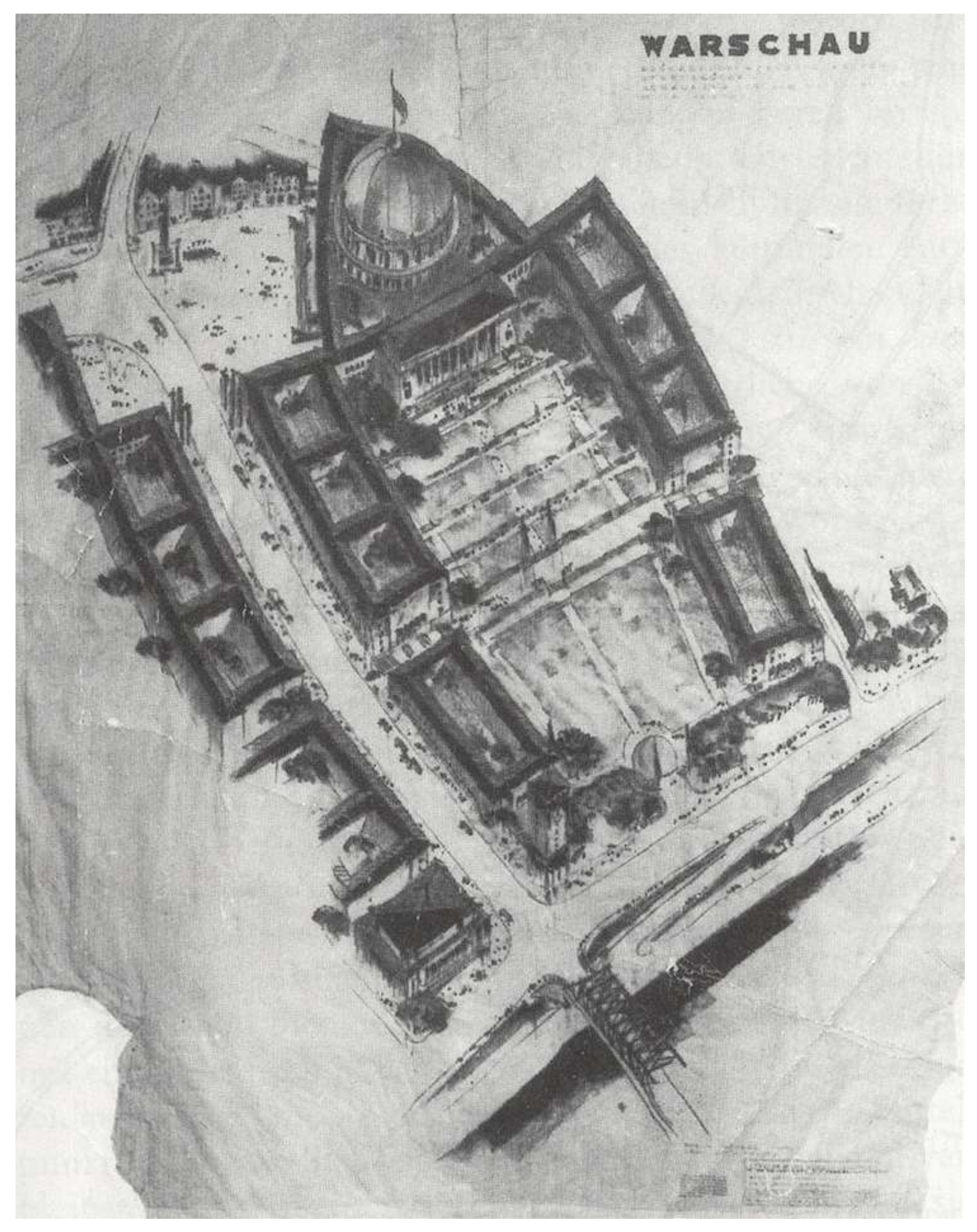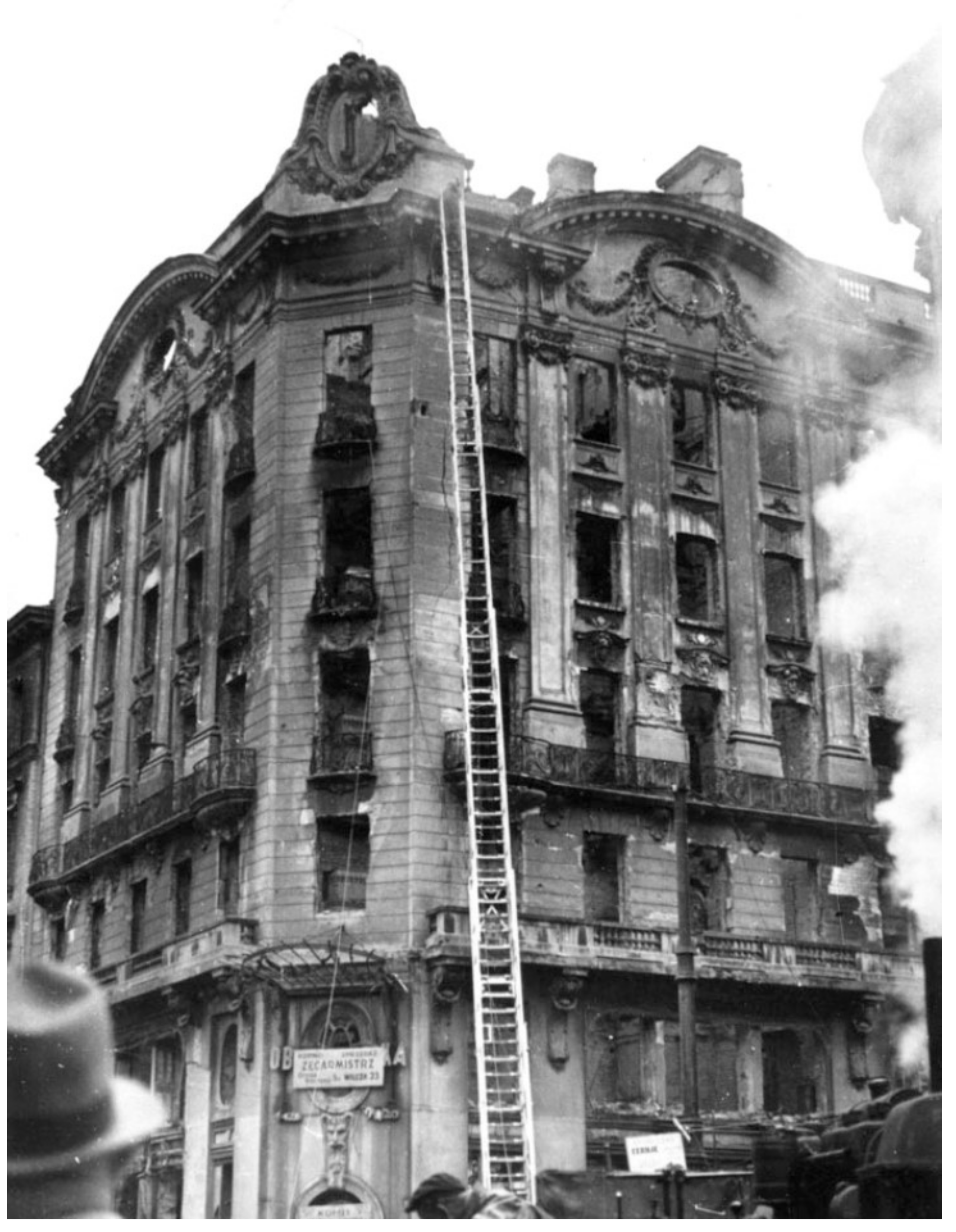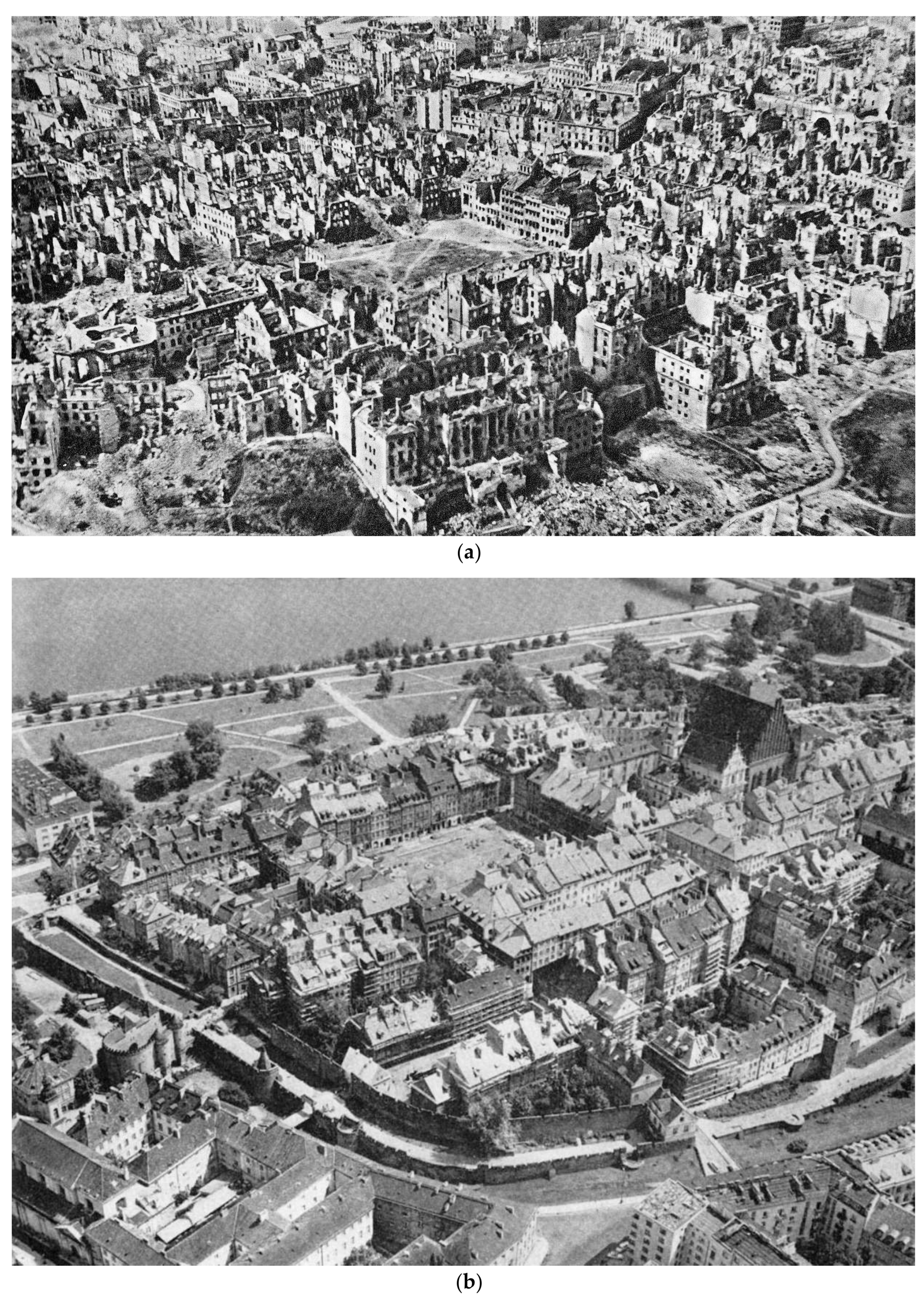5.1. The Case of Warsaw
Seven decades after WWII, our current perspective gives us an opportunity to better understand post-war rebuilding and its influence on the present-day city image. More general reflection enables the evaluation of the complex processes of both destruction and reconstruction [
23].
In Warsaw, throughout the war and German occupation, conservators and architects were protecting historic documentation and saving works, such as a set of relic building measurements, including the Warsaw Old Town, and designed plans for reconstruction even while the buildings were collapsing around them. Professors Jan Zachwatowicz and Stanisław Lorentz acted as representatives of the Polish Underground State tasked with preserving Polish cultural heritage.
The power and vitality of the city were proven after the war when thousands of residents returned to a townscape literally reduced to rubble. Their collective efforts eventually restored the original appearance of the oldest districts through a program of arduous research and reconstruction. In 1946, a writer for
The Warsaw Escarpment attempted to explain why a return to architectural prototypes seemed so essential: “If the Warsaw community is to be reborn, if its core is to be constituted by former Varsovians, then they have to be given back their old rebuilt Warsaw to some extent, so that they can see in it the same city, though considerably altered, and not a different town on the same spot. One must take into consideration the fact that individual attachment to old forms is a factor of social unity” [
13].
It is also likely that Hitler’s well-documented intentions to build a new town on ruins of Warsaw (the project presented on
Figure 4. was a part of that scheme) made the resurrection of Poland’s capital a necessary demonstration of defiance and resilience. Immediately after the war, it was discussed whether to rebuild Warsaw—over 85% of which was demolished—or leave the city, once with a population of 1.4 million (and almost completely deserted as a result of expulsion at the end of 1944), as a site of remembrance. However, the returning survivors, longing for what had been destroyed and fuelled by defiance, spontaneously turned towards reconstruction.
It might seem that the instant rebuilding of Warsaw was the most obvious solution, but the time perspective shows the complexity of that process. The question of the removal of the multi-layered sea of debris was first among the problems, and the next was how to evaluate the substance for further reconstruction. Should the rebuilding be quick—in order to accommodate thousands of homeless—or precise—to meet the conservational criteria? In Warsaw, two powerful ideologies: modernism and socialist realism were impacting the post-war rebuilding process.
Józefacka [
24] treats the rebuilding campaign of the late 1940s and early 1950s as an effort to not only combat the devastation caused by the recent war, but also to further undo the perceived damage wrought by the
laissez-faire development dated to the prolonged era (1795–1918) of partition by neighbouring empires, a preoccupation of the interwar urban planners.
The Bureau of Capital’s Rebuilding soon was established. The architects who worked for the Bureau mostly followed the ideas of functionalism and—supported by the Soviet puppet Communist regime averse to bourgeois architecture—decided to renew Warsaw in the modern style, with wide streets and large free areas. Many existing buildings and buildings that could have been rebuilt were further demolished (e.g.,
Figure 5).
The eventual political agreement for the scrupulous rebuilding of the most precious parts of the historic city of Warsaw was primarily the result of the determination of the inhabitants and the support of the whole nation. The reconstruction of the Old Town (
Figure 6), the New Town, the Royal Route, and the Royal Baths was the grassroots manifestation of the care and attention, expertly supported by the conservators and art historians who had been preparing the documentation for the reconstructions since the first bombardments of Warsaw in 1939. They also acquired a collection of measured drawings developed mostly in the interwar period by the students of the Faculty of Architecture of Warsaw University of Technology.
In Warsaw’s Old Town, the reconstruction included the holistic recreation of the urban plan, townhouses, the city walls, important religious buildings, and the Royal Castle (
Figure 7). The final decision was to modernise the inner spaces of rebuilt blocks while restoring the image of the old city streets and squares. The comprehensive reconstruction of volumes and facades was entwined with an improvement of the attractiveness of this part of town for residents in terms of technical aspects. The extant features were combined with reconstructed ones, which “led to the creation of an urban space unique in terms of its material dimension (the form of the oldest part of the city), its functional dimension (as a residential quarter and venue for important historical, social, and spiritual events), and its symbolic dimension (an invincible city)” [
20].
It was unique not only in light of the conservational theory, but also, and more importantly, in comparison with the uniform ideological character of socialism and communism. This can be explained by the willingness of the communist government to take advantage of the potential of meanings attached to monuments for their own propaganda objectives. The patriotic rhetoric became the government’s tool of legitimization, which concealed the fact of the sovereignty limitation. Before 1989, in the public life of communist Poland, there was little space for forms of social memory other than national.
In 1980, UNESCO included the reconstructed
Historic Centre of Warsaw on the World Heritage List, appreciating its outstanding universal value and stating that it meets two selection criteria: firstly, “to exhibit an important interchange of human values, over a span of time…”; and, “to be directly or tangibly associated with events or living traditions, with ideas, or with beliefs, with artistic and literary works of outstanding universal significance.” The reconstruction of Warsaw’s historic centre was described as “a major contribution to the changes in the doctrines related to urbanisation and conservation of cities in most of the European countries (…). Simultaneously, this example illustrates the effectiveness of conservation activities in the second half of the 20th century, which permitted the integral reconstruction of the complex urban ensemble” [
20].
The reconstruction project utilised any extant, undamaged structures built until the 18th century, together with the medieval network of streets, squares, the main market square, and the circuit of city walls. Two guiding principles were followed: firstly, to use any reliable archival documents, and secondly, to aim at recreating the city’s late 18th-century appearance. The latter was dictated by the availability of detailed iconographic and documentary historical records from that period. Additionally, conservation inventories compiled before 1939 and after 1944 were used, along with the scientific knowledge and expertise of art historians, architects, and conservators.
“The cohesive rebuilding process came to an end with the reconstruction of the Royal Castle. Since then, the Historic Centre of Warsaw has fully retained its authenticity as a finished concept of post-war reconstruction” [
20]. For political reasons, the Warsaw Royal Castle was restored quite late (1971–1984), and basically from scratch. It is actually founded two meters higher than the original structure but contains numerous original elements that were hidden during the Siege of Warsaw (8 September–1 October 1939) and later, during the German occupation (1939–1945), by a number of people who risked their lives to save and hide as much as possible from the bombed castle before it was finally blown to bits. The reconstructed castle’s interiors consist of lots of original elements among exact replicas and copies.
In 2011, the Archive of the Warsaw Reconstruction Office, housing documentation of both post-war damage and the reconstruction projects, was inscribed in UNESCO’s Memory of the World Register.
Further renovations, which occurred across Poland after it regained independence and established democracy in 1989, added some important final touches to the works of the 1940s and 1950s. One of the recent examples is a refurbishment of Krakowskie Przedmieście St in Warsaw, following its partial pedestrianisation (2017) (
Figure 8 shows the new image of the street in comparison with its state in 1945).
5.2. The Case of Gdańsk
The city of Gdańsk has a complex history. The struggle for ‘ownership’ of Gdańsk was characterised in particular by a number of turning points in the city’s history, which included the period after WWI, when, as a result of a Polish–German controversy, the international community decided to create a neutral Free Town.
In 1945, when Gdańsk was acknowledged as Polish, its Old Town was destroyed by 90%. Some of the damage happened during fights; the most was an effect of a post-war demolition and fire set by Soviet troops. Residents who survived and could not escape had to face the Soviet Army, which meant large-scale rape and looting. After the war, the Gdańsk population had to be almost completely recreated. The new Polish inhabitants were mostly displaced from the territories that became republics of the USSR and ruined areas of central Poland.
The reconstruction of the Main Town in Gdańsk, which already had started in 1945, is regarded as another significant example of the Polish School of Conservation, although not all of its principles were strictly observed. Apart from a detailed reconstruction of the most precious monuments, the idea was to create a cultural landscape that would provide an idea of what the destroyed city had looked like. The concept was to fully preserve the medieval street network and the layout of building compounds of the Right Town. The Old Town and the destroyed areas of the suburb were to be transformed to a considerable degree. The burgher houses were to be rebuilt in their historical forms, which should be understood as rebuilding the façades or street elevations rather than a full reconstruction of every building.
In accordance with newly-realised ideas of socialism, the old districts were reconstructed as working-class housing estates but with an excessive number of public buildings due to an increased presence of historical edifices. It resulted in the construction of a new urban structure; single burgher houses were replaced with long blocks of flats divided into segments corresponding to the divisions of historical plots and covered with a screen of individual façades. Historical public edifices, such as a town hall and churches, were rebuilt or restored in general conformity with principles of conservation. In most cases, their parts (vaults, roofs, tops of towers) had to be reconstructed [
25]. Conservation discipline was applied to the major streets and the city panorama visible from the Motława River. The compact urban fabric of a modern working-class district became a natural background behind the monumental gothic edifices and Renaissance façades.
The opportunity was taken to de-Germanize Gdansk during the architectural restoration of the medieval and Renaissance city. It was decided to refer to its golden era of the 16th and 17th centuries and the whole period between 1454 and 1793, when Gdańsk was the largest city and fortress within the borders of the Polish Kingdom. Thus, it was decided to eliminate eclectic buildings of the late 19th and the first half of the 20th centuries. The political attitude toward the architecture of German Neo-Renaissance, derogatively referred to as “Prussianism”, resulted in its removal from the panoramas of several cities in the “Regained Territories”. However, it should be stressed that those activities were directed toward the relatively new neo-style buildings, which had been created mainly over the previous 50 years, and which were generally lowly rated [
26]. The only reason for their survival was the relatively good shape of certain objects, which, due to economic reasons, made it difficult to replace them with new ones.
Demolitions also resulted from the low standard of the 19th-century tenement buildings that had grown within the tight borders of Gdańsk—a city which was at that time overpopulated and enclosed by fortifications—and the propaganda of German identity that was written into them (Gdansk was annexed by the Kingdom of Prussia in 1793 in the Second Partition of Poland. With the unification of Germany under Prussian hegemony, the city became part of the German Empire. At the turn of the 20th century, Kaiser Wilhelm II, together with a close circle of politicians and artists, consciously used architecture as a political tool by creating a broad range of efforts to integrate art and architecture into the Empire’s cultural unification processes [
27]).
Completely burned 19th-century tenement buildings along the line of the former city fortification were also demolished, which made it possible to recover entire sections of curtain walls. In line with the principles of the Polish School of Conservation, a green belt complex referring to the medieval city fortification system was created, which clearly delineated the Main Town. In similar cases in Poznań and Warsaw, a decision was to fully reconstruct medieval defence systems (although ultimately it was achieved only in Warsaw). In Gdańsk, only fragmentary activities were conducted due to insufficient funding; however, the exposed remains of the city fortifications still dominate the character of the Main Town green belt area [
28].
In his lecture delivered on 25 July 1947, Władysław Czerny, an urbanist and vice-mayor of Gdańsk, noted that the historical reconstruction of the Main Town “is not only an artistic postulate but also a deeply justified city-planning reason. The layout of streets, the entirety of the city surrounded by a belt of walls, had its deep justification which (…) has lost nothing of its reason and purpose.”(Władysław Czerny as quoted by: Marian Des Logos, DziennikBałtycki, no. 210, 2 August 1947, p. 3, after [
28]). The urbanist also noted that modern buildings located next to a historical complex must not compete with it and must not spoil its shape [
28].
The scale and the totality of the Gdansk rebuilding have brought irreparable loss of numerous survived walls, vaults or details—the authentic fabric, which by definition should be subject to architectural conservation—but the greatest value of the undertaking was that it has recovered the city for the cultural landscape. It was possible owing to the reconstruction of street elevations in more or less reliable historical forms.
In the 1990s, the democratisation of life exposed and revealed hidden layers of social memory and opened up new possibilities for social activity formerly unrepresented in public life. Proud of the great anti-communist Gdańsk revolts of the 1970s and 1980s, the new generation of citizens threw away their complexes and resentments and looked back on the city’s past with courage. The publication of documents, literary works, and pictures of pre-war Gdansk became a trigger for a social debate about the city’s identity. Historic cityscape and monuments—those which survived and those who did not—represent social memory. The citizens of Gdansk are eager to get involved in a debate about the identity of their city and their own bonds with it. This debate shows how the perception of historic landscape develops and how the collective memory spontaneously evolves. The changes of attitudes are reflected in the politics of memory and the search for the city’s multicultural identity [
29].
This search has been carried out at the grassroots level. It revealed the actual differences between the former manner of governing the population and present democratic self-governance of citizens, which occurred in the 1990s, but had its roots in the Solidarity movement of the early 1980s. The bonds and intimacies of social networks and the freedoms and liberties of their citizenries eventually helped to fully consider moral dimensions and orders of location, time, cityscape, and place.
Increasingly visible signs of development and care can be perceived in Gdańsk over the recent decades. One can observe the significant interest of local NGOs and individual citizens in the history of their city, its appearance, recollections, and discoveries. The care for historical spaces often leads to vivid discussions regarding their past and future. Social memory is becoming increasingly open and individualised. The myths of Gdansk as either Polish or German has been replaced with the myth of a multicultural city (which is not yet the case of Gdańsk, which, since WWII, is still primarily inhabited by Poles). What truly joins all inhabitants of Gdańsk throughout the centuries is rather their sense of liberty [
30].
5.3. The Case of Wrocław
Wrocław is another interesting case, especially if compared with both Polish and German cities destroyed during WWII. The rebuilding of German cities such as Berlin, Dresden, and Frankfurt am Main were mainly based on urban reconstruction, whilst, on the building scale, their architecture was in most cases not recreated, but replaced by modern buildings. Some landmarks were reconstructed historically, although in a simplified style.
Wrocław, as a city that for four centuries was under Austrian, Prussian, and German rule, has considerable German architectural heritage. At the end of the war, the city was transformed into a fortress—Festung Breslau. Most of the civilian population escaped before Soviet troops surrounded the city. It was bombed and desperately defended for three months, being the last stronghold of the Nazis. When, as a result of the Potsdam conference, Wrocław was handed back to Poland, 70% of the city and 90% of the Old Town was in ruins.
Similar to Gdańsk, after the war, Wrocław was populated by Polish repatriates forced to leave eastern areas of the former Republic of Poland that had been annexed by the Soviet Union, including cities like Lvov, Vilnius, and Stanisławów. Just in the first year after the war ended, about 166,000 people settled in Wrocław and started rebuilding the city. Unlike those in Warsaw, and similar to Gdańsk, the new Wrocław inhabitants were uprooted. However, people tied into the rebuilding in the hope of moving beyond the horror of war and overcoming the enormous losses the country had suffered. In their search for an identity, they yearned for tradition just as much as they lacked it [
31].
The population of immigrants from different backgrounds shared only their prejudice against former occupants of the city. However, the whole intricate geopolitical history of the town has made it a unique melting pot. The town bears witness to the succession of supremacy of several nations. Wrocław as a “true Polish city” was first the product of the Soviet anti-German politics and then the subject of long-lasting propaganda. New citizens were submitted to indoctrination and ideological campaigns. Much of the early propaganda was based on the premise that a huge part of the local heritage is foreign and hostile and thus needs to be eradicated and substituted [
32]. The Soviets and the communists aimed to de-Germanise the city, which was generally accepted and eagerly enforced by some of the newly arrived inhabitants suffering the trauma of the war, cruel German occupation, and post-war resettlement.
The process of rebuilding the city was characterized by a mix of de-Germanisation and re-Polonisation, which led to a simultaneous destruction and reconstruction. Only medieval and Renaissance objects were safe, whilst many sculptures, statues, and grandiose eclectic edifices associated with Prussian reign were torn down. The authorities launched a campaign of selective restoration and reconstruction of townhouses in Wrocław’s Old Town. The medieval architecture was painstakingly restored, propagating the account of an ancient Polish city, while many testimonies of later eras deteriorated. The process also included the removal of almost all German non-religious statues and many inscriptions—which was an act of retaliation for the ruthless and punctilious de-Polonisation of territories occupied by Germany during WWII.
However, for several following decades, though Wrocław has seen its share of symbolic and ideologically motivated demolitions, restorations, and reconstructions, there seemed to be no coherent policy behind them. If any philosophy dominated, it was the Polish School of Conservation, led by Prof. Zachwatowicz. The reconstruction of Wrocław’s historic centre (1953–1962) was one of the largest such projects undertaken in Poland after the war. In effect, alongside medieval monuments associated with the Polish history, surprisingly numerous buildings of German origin were also restored. According to Davies and Moorhouse, the war and expulsions may have influenced the geopolitics, but they could not erase all those hundreds of years of Slavonic-German interaction and overlapping of cultures [
33].
When the Iron Curtain collapsed in 1989, it paved the way for city leaders and residents to finally acknowledge Wroclaw’s various heritages. The 1990s and 2000s saw Wrocław discovering, accepting, and incorporating its multidimensional, multi-ethnic legacy. The city has found its identity in the recognition that it has many identities. The citizens, as well as the authorities, have reached out to embrace the German cultural contribution to the city. They realized that the debates lead to a healthier society with a more stable characteristic. The residents began to track and restore remnants of German inscriptions, statues, and other traces of a pre-war society [
32,
34]. The Internet databases and registers have been developed (such as Wratislaviea Amici: [
35]), documenting the relics of the former iconosphere of the city and the region.
After decades of persistent renovations resumed in the 1990s, it became vivid how much once mutilated cityscape of Wrocław, as much as Gdańsk, maintained an impression of continuity. Today, Wrocław reveals little of the dramatic rupture of 1945. The central squares and streets in the Old Town, with Medieval, Baroque and Fin-de-Siecle façades of the patrician and bourgeoisie houses, look as if they had survived the war without any damage [
31]. With its minutely restored, diverse historical architecture and assertive society, Wrocław might be used as a model for all those cities dealing with unresolved, suppressed conflicts of the past [
36]. However, the recent regeneration would not be as successful without the pioneering works of Zachwatowicz and his co-operators.











